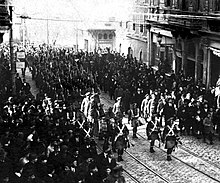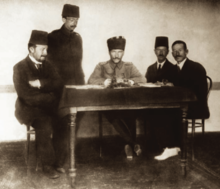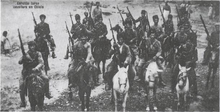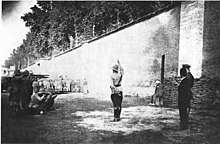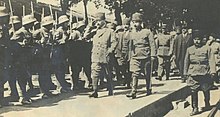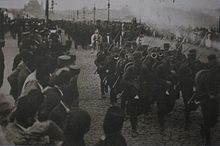Turkish Liberation War

On September 9, 1922, the Turkish troops took the city of İzmir, which had been occupied by Greece since May 15, 1919.
| date | May 19, 1919 to October 29, 1923 |
|---|---|
| location | Asia Minor and Thrace |
| Casus Belli | Occupation of Turkey by the Western powers |
| exit | Turkish victory |
| follow | Establishment of the Republic of Turkey Population exchange between Greece and Turkey |
| Peace agreement | Treaty of Lausanne |
| Parties to the conflict | |
|---|---|
|
supported by:
|
|
| Commander | |
|
|
|
| Troop strength | |
| 250,000 men | 400,000 men (all opponents in total) |
Smyrna I - Aydın - İnönü I - İnönü II - Eskişehir - Sakarya - Great Offensive ( Dumlupınar - Smyrna II )
The Turkish War of Liberation ( Turkish Kurtuluş Savaşı or older Turkish İstiklâl Harbi ) was the war of independence of the Turkish national movement from 1919 to 1923 under the leadership of Mustafa Kemal Pasha against the occupation and political and economic tutelage by foreign powers. The fighting was directed against Armenia , Greece and the French occupying power in Anatolia, which were supported by the Western powers Great Britain and Italy . The war was against the enlargement of a projected Armenian and Greek state at the expense of the Ottoman Empire as well as against the above. Zones of occupation directed according to the Treaty of Sèvres of 1920. The aim was to establish a Turkish nation state within the ceasefire lines agreed with the Entente in the Mudros armistice of 1918 (roughly corresponds to today's borders). Furthermore, the Turkish state should be free from political and economic restrictions by foreign powers. The allied partition plans of Turkey anchored in the Treaty of Sèvres of 1920 had been signed by the government under Damat Ferid Pascha , but provoked successful resistance under Mustafa Kemal. The troops of the Kuvayı Milliye under the leadership of Mustafa Kemal joined various ethnic groups, such as B. Circassians , Lasen and Kurds . The common Turkish names are Kurtuluş Savaşı ( War of Liberation ), İstiklâl Harbi ( War of Independence ) or Millî Mücadele ( National Struggle ).
The aim of the struggle was the establishment of a sovereign Turkish state without political, legal and economic tutelage from other states. In addition, a common Turkish national consciousness should be established among the well over 40 ethnic groups, of which the Turks were the largest ( see also: Ethnic groups in Turkey ).
The war of liberation culminated in the Greco-Turkish war , as a result of which most of the Greek population of Asia Minor and the Turkish population of today's Greece were expelled (agreement between the two countries on population exchange 1923). The Greeks had to leave parts of Asia Minor, where they had settled for nearly three thousand years (mainly in Ionia , on the Pontus , in Bithynia and in Eastern Thrace ). For the Turks, on the other hand, an almost 600-year-old history of settlement ended in parts of present-day Greece (mainly in (Greek) Macedonia and on Crete ).
initial situation
The Ottoman Empire , allied with the Central Powers during World War I , signed the Mudros ( Mudros auf Limnos ) armistice with the victorious powers after their defeat had become apparent on October 30, 1918 . Chapter 7 of the treaty allowed the victorious powers to occupy any region of the empire at any time. On the basis of this agreement almost all areas of Turkey were occupied by Great Britain, France, Italy and Greece.
Greece had joined the Entente in World War I and, after the defeat and weakening of the Ottoman Empire, saw the Megali Idea within reach. With the support of the great powers Great Britain and France, Greece began a campaign against the war-weakened Ottoman Empire.
The beginnings of resistance
Response to the crew
Resistance against the occupation was organized in many parts of the country. The Kuva-yi Milliye were volunteer corps , which organized locally recorded the struggles against the occupying powers. The volunteer corps consisted of members of the disbanded Teşkilât-ı Mahsusa , young Turkish prisoners who were about to go to trial under the Istanbul government and who had switched to the Kemalist side with the help of the Karakol organization, deserted soldiers of the Ottoman army and other volunteers.
The first shot against the occupying powers in İzmir by Hasan Tahsin marks the beginning of the resistance . The Kuvayı Milliye were not only fought by the occupiers, but also by the government of the Ottoman Empire.
Mustafa Kemal's arrival in Samsun
Mustafa Kemal came to the conclusion that the resistance could only be directed from Anatolia and not from Istanbul.
In 1919 he got the chance he and other officers had been waiting for. Growing resistance and unrest in central Anatolia worried Britain. Great Britain threatened the Sublime Porte with the occupation of the region if the Reich failed to ensure peace and order. The Sultan commissioned Mustafa Kemal with the demobilization of the 9th Army and sent him to the Black Sea coast. His arrival in Samsun on May 19, 1919 marked the beginning of the war of liberation and is still celebrated today in Turkey as a national holiday.
After his arrival, Kemal wrote in a letter ( Havza Genelgesi ) calling on other officers to hold meetings all over the country, to inform the population about the plans of the occupying powers and to organize resistance. The first such meeting was held in Havza on May 30, 1919.
Nationwide congresses
The congresses held served to found a unified national resistance movement and to give it national legitimation in addition to a program. The aim was to unite the decentralized and independently acting forces. At the congresses in Erzurum (July 23 to August 7, 1919) and Sivas (September 4 to 11, 1919), strategies for the liberation of Turkey were defined in a national pact (Turkish: Misak-ı Millî ). The goal was defined as the indivisibility of all areas that were mostly inhabited by " Turks ". It is still considered the founding document of the republic today.
Congress of Erzurum
In the meantime, patriotic societies called the "Society for the Defense of Rights" ( Müdafaa-i Hukuk Cemiyeti ) were established all over the country . In his “ Amasya circular” ( “The independence of the people is regained through the determination and decision of the people” ), Mustafa Kemal called on all local societies to join forces in a national congress. This should legitimize the political movement and the later military measures by the people.
Mustafa Kemal held the first congress from July 23 to August 7, 1919 in Erzurum. Previously, on July 8, he resigned from his rank as Pasha and left the Ottoman Army. The next day he was elected chairman of the congress in Erzurum.
56 delegates from the cities of Erzurum , Sivas , Bitlis , Van and Trabzon met under his chairmanship . The delegates were members of the Sancaks , the old Ottoman administrative units. On July 23, Congress passed a 10-point resolution. It called for the restoration of the Ottoman Parliament and the independence, sovereignty and indivisibility of the Turkish state. The representatives of the six eastern provinces also voted to remain in the empire. This decision was directed against the establishment of an Armenian state.
Congress of Sivas
On September 4, 1919, the second congress took place in Sivas. The delegates met at the congress and confirmed the decisions of Erzurum. It was also stipulated that all Müdafaa-i Hukuk societies should join together to form the "Society for the Defense of the Rights of Anatolia and Thrace" ( Anadolu ve Rumeli Müdafaa-i Hukuk Cemiyeti ). The congress elected a 15-member representative committee ( Heyet-i Temsiliye ), whose chairman Mustafa Kemal was elected. This body has been given extensive powers to represent the nation.
The Amasya meeting
As chairman of the committee, Mustafa Kemal made the following demands on the Ottoman government on October 20: The government should adhere to the resolutions passed by Erzurum and Sivas, and not take any far-reaching decisions before the Ottoman parliament ( Meclis-i Mebusan ) reconstituted, and the representative committee should be consulted on government decisions.
The Ottoman government sent a representative to come to an agreement with Mustafa Kemal. At the meeting in Amasya, the two parties reached the following resolutions:
- The government of Constantinople will adhere to the decisions of Erzurum and Sivas if the new parliament approves the decisions.
- The "Society for the Defense of the Rights of Anatolia and Thrace" is legally recognized as an organization by the government.
- Foreign occupation is not accepted in regions with a predominantly Turkish population.
- All non-Muslim sections of the population are not granted any special rights that could disturb social peace.
- For security reasons, a meeting of Parliament in Constantinople is not acceptable.
- In the peace negotiations, the representative committee is involved in the selection of the delegates.
Congress of Thrace
The Congress of Thrace was held between May 9 and May 13, 1920. 217 delegates attended the congress, including the resistance fighter Ahmet Muhtar Merter . The Congress stated that the majority of Thrace was Turkish and Muslim and that it belonged to the Ottoman Empire. At the same time, the Congress refused to join Greece. It was also decided that armed resistance should begin in the event of a possible occupation by Greece.
Establishment of the Turkish Parliament
The demands of the representative committee for a new patriotic government and a new parliament were implemented by the sultan in December 1919 when he called new elections. Nationalists and supporters of Mustafa Kemal emerged victorious from the elections. The "Group for the Salvation of the Fatherland" ( Felâh-ı Vatan Grubu ) won the majority of the seats in the new parliament.
On January 12, 1920, the Ottoman Parliament met for the last time and agreed to Amasya's demands and adopted the “National Pact” of the Anatolian Resistance. The national pact is also important in that it laid down the state borders of a future state. They should be within the Mudros peace treaty lines. In doing so, parliament gave up all imperial territorial claims in Arabia , the Caucasus and the Balkans .
The resistance movement redefined the state not only geographically but also ethnically. She defined Anatolia and the predominantly Muslim areas as her state territory.
Great Britain occupied Constantinople on March 16, 1920 to prevent national activities. Leading party members of "Salvation of the Fatherland" were arrested. The Sultan then dissolved parliament. At the same time, Greek troops began to penetrate deeper into the Anatolian interior.
After the dissolution of the Ottoman parliament, Mustafa Kemal invited the parliamentarians to Ankara. On April 23, 1920, the new Türkiye Büyük Millet Meclisi was constituted with 324 parliamentarians and the Representative Committee ( Heyet-i Temsiliye ) was dissolved. Of these 324 MPs, 92 were members of the defunct Ottoman Parliament and the remaining 232 were representatives of the Müdafaaihukuk Cemiyeti (Society for the Defense of the Rights) movement from across the country. Only 115 parliamentarians were able to travel to the first parliamentary assembly. The first resolution of the Türkiye Büyük Millet Meclisi on that day was the founding resolution of the Parliament with the name Türkiye Büyük Millet Meclisi. On April 24, 1920 Mustafa Kemal was elected President of Parliament with 110 out of 120 votes. A temporary Turkish government was formed on April 25, 1920, and the first Turkish Republican government chaired by Mustafa Kemal on May 2, 1920.
In August 1920 the National Assembly received the news that the delegation sent by the Sultan to Paris had signed the Peace Treaty of Sèvres , thereby agreeing to the dismemberment of the empire. The National Assembly rejected the treaty and declared the government representatives high traitors. On January 20, 1921, the new Turkish constitution was passed .
Occupation under the Treaty of Sèvres
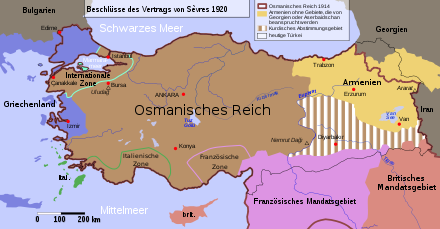
The provisions of the Mudros armistice provided for a complete demobilization of the Ottoman forces and occupation rights of the Allies. The allies Great Britain, France and Italy had already marked out their areas of interest during the war. The Greeks were also granted an occupation zone around Izmir, in an area that, according to the original agreements, should fall to Italy. Greek troops landed in Izmir in May 1919. The Greek government used a request for help from the Allies to provide troops to defend Istanbul to cross the borders of their zone of occupation and in the course of the summer of 1920 occupied the Marmara region of Asia Minor and invaded the Anatolian interior.
The widespread collapse of Ottoman rule, the large number of weapons that were available and left behind, the increasing resistance of the national forces that gathered around Mustafa Kemal, and the disunity of the Allies created a confused situation. The United States pursued an increasingly isolationist policy, France put its main focus on securing the German Reich against revanchist tendencies and Italy felt cheated of its colonial wages for entering the war on the side of the Allies. Great Britain was not only economically exhausted by the First World War, but also saw itself challenged in Asia by Soviet Russia . In addition, the British government had to be considerate of the feelings of the Muslim subjects of the Empire, especially in India, in the treatment of the Ottoman sultan and caliph.
Against this background, the Sèvres Peace Treaty was signed on August 10, 1920. In addition to the loss of the Arab provinces, with which Turkey had already come to terms, the original war aims of partitioning Turkey and its displacement from Europe should be pursued if possible. Turkey should be left with a rump inner-Anatolian state .
The straits with the adjacent territories, including the Ottoman capital Istanbul, should be internationalized. Greece was assigned to Eastern Thrace almost to the city limits of Istanbul, with certain restrictions resulting from the internationalization of the straits.
The eastern parts of today's Turkey, with the cities of Kars , Ardahan and Batumi , which were Ottoman until 1878 and which the Ottoman Empire had regained in the peace of Brest-Litovsk in 1918, had to be ceded again. It was planned that these areas (partially) and (unilaterally) still to be determined areas in Eastern Anatolia should be added to the Republic of Armenia, which was founded in May 1918 . The US President Woodrow Wilson had taken over the determination of the borders of Armenia, which was to get Erzurum , Van , and a Black Sea access at Trabzon . But it was already foreseeable that the Republic of Armenia could not take possession of these areas and was also threatened by Soviet Russia. Outside of the treaty, a US mandate for Armenia was therefore politically sought, but that was no longer possible.
The extra-Anatolian territories in Syria and Mesopotamia were ceded, and the annexation of Cyprus by Great Britain was recognized. The islands of the Dodecanese, which had already been occupied by Italians, including the newly acquired Kastelorizo , fell to Italy. Syria and Lebanon were to become the French mandate of the League of Nations , with the border with Turkey lying well north of today's and the mandate area should include parts of Cilicia .
The region around Izmir was under Greek occupation and administration. The parliament of the zone of occupation should decide after a few years whether to join Greece.
In addition, the Allies reserved occupation rights. Internally among the winners and outside the peace treaty, it was agreed that outside the Smyrna area, south-western Anatolia with Antalya and Konya should be Italian and large parts of eastern Anatolia as far as Sivas, French areas of interest.
To the south of the area that falls to Armenia and east of the Euphrates , the Kurds were granted an autonomous region and the possibility of a later secession promised.
Turkey should only encompass an area around Ankara in Central Anatolia , which should also remain under foreign financial and military control. The treaty only resulted in the sultan's government losing all legitimacy in the eyes of the majority of the population.
War of liberation

The war against the occupiers was initially carried out by militia forces from the Kuvayı Milliye. These armed forces united with the regular Turkish army, which was formed by decision of the Grand National Assembly of Turkey.
Riots
In the course of the War of Independence there were repeated uprisings. They were ethnically and religiously motivated. The latter was supported by the Sultan's government and was directed against the new government in Ankara. The first measures taken by the government under Mustafa Kemal concerned the suppression of the various uprisings. With English support, the Ottoman Empire formed a new caliphate army ( Kuva-yi İnzibatiye or Hilafet Ordusu ). This was defeated despite good equipment by Mustafa Kemal's troops. There were riots, among other things. held in Konya and Urfa ( Milli Aşiret Ayaklanması ).
Eastern Front
On May 28, 1918 , the Democratic Republic of Armenia with Yerevan as its capital was founded in the South Caucasus in an area that had belonged to the tsarist empire . According to the ideas of the Allies, as expressed in the Treaty of Sèvres, this should be greatly increased. The parliamentary government under Mustafa Kemal commissioned Kâzım Karabekir in 1919 to defend the areas claimed by Armenia and to recapture the areas already occupied by Armenia. Kâzım Karabekir advanced with his units towards the Caucasus. The cities of Sivas , Erzurum , Kars and Ardahan were conquered and the Armenian troops pushed back. The Kemalists continued the Young Turkish policy of extermination against the Armenians. At Alexandropol alone, 60,000 Armenian civilians were killed.
After the Turkish victories, an armistice agreement was signed on November 18, 1920.
On December 2, 1920, the Treaty of Alexandropol was signed, the first international law treaty concluded by the National Assembly in Ankara, but it was no longer of practical importance because Armenia was occupied by Soviet troops 4 days later and the Democratic Republic of Armenia so that it would come to an end.
In the Treaty of Moscow of March 16, 1921, the Turkish parliament agreed with Soviet Russia on the border in Transcaucasia.
With the friendship treaty of Kars of October 23, 1921, the still formally independent states of Transcaucasia, the Armenian SSR , the Azerbaijani SSR and the Georgian SSR accepted this result, thus establishing the borders between Turkey and these states that existed today.
South front
In southern Anatolia, France and Great Britain divided parts of the Ottoman Empire among themselves. The British occupied Mosul , İskenderun , Kilis , Antep , Maraş and Urfa, the French Adana , Mersin and Osmaniye . The French deployed the Armenian Legion and Tunisian auxiliaries in the Turkish occupation zones to ensure peace and order.
At the Sivas Congress, the delegates decided to found Kuvayı Milliye in the French zone . The population should also be mobilized against the French occupiers. On February 12, 1920, Maraş was evacuated by French troops and the Turks, led by Sütçü İmam, took control of the city. On April 11, 1920, Ali Saip led the resistance in Urfa to a successful end. In contrast, the uprising in Antep was unsuccessful after a year and 6,000 deaths. On February 9, 1921, the Antep rebels had to surrender. However, the French finally gave up their occupation of Turkish territory with the Ankara Agreement of October 1921 and left the Armenian civilian population, if they had not already fled, to the Kemalist arbitrariness or the revenge of the Turkish victors.
In 1920 the Allies repatriated 100,000 Armenian survivors of the genocide from Palestine and Syria to Cilicia. The change in French policy under the High Commissioner for the Syrian Cilicia , Henri Gouraud , was due to the long-term French interest in Syria and Lebanon. In exchange, Cilicia was offered to the Kemalists. For the repatriated Armenians, the evacuation of Cilicia by the French meant another catastrophe. Pogrom-like attacks by the Turks and the wintry weather claimed an estimated 10,000 deaths among the Armenian community of Maraş, which had also sought salvation by fleeing after the French withdrew.
With the victories in the east and south, the popularity of the new Ankara government increased among the population. The expulsion of the Armenian population of Cilicia by the Kemalists ended the existence of this Christian ethnic group in southern Anatolia.
Western front
After the end of the First World War, Greece received Eastern Thrace (its northeastern border thus ran a few kilometers from Constantinople ) and a large area of the coast of Asia Minor around Izmir from the Ottoman Empire in the Peace Treaty of Sèvres , in which many Greeks settled.
Even before the Sèvres peace treaty was signed, Greek troops occupied Izmir, large areas in the Aegean region and parts of Eastern Thrace on May 15, 1919. On January 6, 1921, the Greek military began a major offensive in Anatolia, which aimed from Bursa and Uşak in the direction of Eskişehir and Afyon . Eskişehir was a strategically important point that allowed the Greeks to get the railway line under control. The Greek army was supported with weapons and material by Great Britain and was far superior to the Turkish military in terms of equipment and food supplies.
After the conquest of Eskişehir, the Greek army advanced towards Ankara to crush the national government. In the city of İnönü she met the Turkish army under the leadership of İsmet Pasha . On January 10, 1921, the First Battle of İnönü came about , which the Turkish army was able to end victoriously. Mustafa Kemal took advantage of this victory and on January 20, 1921, enforced the new constitution, which said: "All violence comes from the people". The new constitution thus challenged the sultan's authority. For the first time, the government in Ankara officially emancipated itself from the old Ottoman order and the monarchy .
In the second battle near İnönü, the Greeks again advanced towards central Anatolia and, this time successfully, occupied Bilecik , Uşak and the Metris hills near İnönü on March 23, 1921 . Then the Turkish troops under Ismet Pasha went on the offensive and defeated the Greek soldiers for the second time. The Greeks had to retreat to Bursa on April 1st, so İsmet Pasha managed to stop the Greek advance in the two battles of January and April 1921, İsmet Pasha later received the family name İnönü as a tribute to his victories in the city of the same name .
In July 1921 the Greek army went on the offensive again. The Turkish troops had to withdraw in the battle of Kütahya and Eskişehir. After the Turkish defeat, Mustafa Kemal was appointed commander in chief of the Turkish army. On August 7th and 8th, 1921, national mobilization ( Tekalif-i Milliye ) was proclaimed. The population was thus obliged to provide the military with all the materials and resources they needed.
On August 23, there was the decisive battle on Sakarya (August 23, 1921 to September 13, 1921), where 45,000 Turkish soldiers fought against 89,000 Greek soldiers. The troops under Mustafa Kemal won an important victory in the Battle of Sakarya , in which the Greeks lost 30,000. After this victory, the French troops withdrew from Turkey and gave up their territorial claims against Turkey with the signing of the Franklin Boullon Agreement ( Treaty of Ankara ) in 1921 . Thereupon the Italians and finally the British also left the country.
One year after the Sakarya battle, which was used in preparation for the further war, the Turkish army went on the offensive on August 26, 1922 under the leadership of Mustafa Kemal. On August 26th and 27th, the Greek defenses were broken and the army marched into Afyon. On August 30th, large parts of the Greek army were defeated. The commander-in-chief of the Greek army, General Nikolaos Trikoupis , was captured. Since this victory, August 30th has been celebrated in Turkey as “Zafer Bayramı” ( Victory Day ). The disintegrating Greek army withdrew in a disorderly direction towards Izmir, its soldiers were partially evacuated from British and French ships under chaotic conditions.

The war ended on September 9, 1922 with the capture of the then largely Greek-populated city of Izmir by Turkish troops .
“The Greek troops had left the city the day before, and Mustafa Kemal Paşa visited them a day later. For İzmir, the war went a little further. The Turkish governor Nur üd-Din Paşa had the Greek metropolitan Chrystostomos lynched. Armenian associations continued to fight the Turkish troops. At the same time, Turkish residents of the city began to take revenge for the often degrading treatment during the occupation. The story of the cosmopolitan İzmir […] came to a bloody end. On November 13th, fires broke out in several places in the Armenian neighborhoods. It is as good as certain that it was laid; it is disputed who did it - Turks seeking revenge or Armenians who pursued a policy of the burned city. The lower districts, mostly inhabited by non-Muslims, but also the bazaar, burned down. Most of the Turkish quarters, as well as some parts of Alsancak, which is still upscale today, were spared. "
The journalist and eyewitness Falih Rıfkı Atay justified the arson with a mixture of destructiveness and a feeling of inferiority as well as the fanaticism of the military governor Nureddin Pasha . The Armenian population of Izmir, which had been spared from the Turkish genocide 1915–1918 under pressure from General Liman von Sanders , was killed or put to flight along with the Greek. The Greek army destroyed or burned many towns and villages on their retreat. In Aydın, for example, only three out of 8,000 houses remained intact. According to the American Vice-Consul of Constantinople, 10,300 houses, 15 mosques, two baths, 2,278 shops, 19 hotels and 26 villas were destroyed in Manisa . 90% of Manisa, 90% of Turgutlu , 70% of Alaşehir and 65% of Salihli were completely destroyed by the Greek army. Thousands of Turkish civilians were also killed or ill-treated through murder, torture and rape, leaving a million Turkish civilians homeless at the end of the war. The last Greek troops left Anatolia on September 18, 1922 .
After the withdrawal of the Greek troops, the victorious Turkish troops turned to the recovery of the straits under Allied occupation, Istanbul and Eastern Thrace. Of the Allies, however, only the British were willing to offer military resistance, but also wanted to expand their military engagement themselves, especially not alone. The unauthorized action of part of the British government in this matter led to the Chanak crisis , which led to the withdrawal of French troops from the Dardanelles , the overthrow of the Lloyd George government and the commencement of ceasefire negotiations between the Allies and the Turkish leadership. On October 11, 1922, the occupying powers closed without the participation of the government of Sultan Mehmed VI. the armistice of Mudanya , and Constantinople came back into Turkish possession.
consequences of war
Establishment of the Republic of Turkey
On October 11, 1922, the Allies in Mudanya negotiated a ceasefire agreement with the Turkish government without the participation of the Greeks. On November 1, the National Assembly voted for the separation of the Sultanate and the Caliphate and for the abolition of the Sultanate. In mid-November, the last Ottoman Sultan Mehmed VI. leave the country. His cousin Abdülmecid II took over the office of caliph.
In the Treaty of Lausanne on July 24, 1923, the provisions of the Treaty of Sèvres were revised, thus preventing the loss of large parts of what is now Turkey's territory and recognizing the new borders under international law.
After all foreign forces had withdrawn from Anatolia, Mustafa Kemal proclaimed the republic on October 29, 1923. Later he was given the surname "Ataturk" ("Father of the Turks") and became the first President of the republic. The Treaty of Montreux of July 20, 1936 gave Turkey back full sovereignty over the straits. In 1939, the Sanjak of Alexandretta, with its Armenian and Arab minorities, was renamed Hatay by the Turks and after a referendum it became part of Turkey.
Consequences for Greece
As a result of the lost war, a coup took place in Greece , and King Constantine had to abdicate. Prince Andreas was demoted and banished on December 2, 1922 for insubordination and treason during the Turkey campaign. Prime Minister Gounaris , together with senior officers of treason accused and in Goudi at the 28 November 1922 Athens executed .
Relocations
The Lausanne Treaty stipulated the forced relocation of 1.5 million Greeks from Turkey and nearly half a million Turks from Greece to Turkey, mostly from northern Greece, Macedonia and the Aegean islands. Exceptions were only made for the Turks in western Thrace and for the Greeks in Istanbul and on the offshore islands of Imbros and Tenedos .
However, many of the remaining people later followed more or less voluntarily (especially after pogroms against the respective minorities) their compatriots who had previously been expelled. The Greek community in Istanbul, which at the beginning of the twentieth century made up around 40% to 60% of the city's population, has now shrunk to a few hundred members. The Turkish or Muslim community in Thrace, on the other hand, has remained largely constant at 80,000 - 120,000 people since the population exchange in the 1920s.
The events of that time were a trauma for many Greeks and Turks and are one of many reasons for the resentment between the two peoples, which in some cases is still smoldering today .
literature
- Edward J. Erickson: The Turkish War of Independence: A Military History, 1919-1923 . ABC-CLIO, 2021. ISBN 978-1-4408-7841-1 .
- Islam II. The Islamic empires after the fall of Constantinople. (= Fischer world history). Frankfurt am Main 1984.
- Klaus Kreiser : A Brief History of Turkey . Stuttgart 2003.
- Marjorie Housepian Dobkin: Smyrna 1922: The Destruction of a City . Kent State University Press, New York 1988, ISBN 0-9667451-0-8 .
- Christoph K. Neumann, Michael Neumann-Adrian: Turkey. A country and its 9000 years of history . Munich 1993.
- Turgut Özakman: Şu Çılgın Türkler. Novel. 26th edition. Bilgi Yayınevi, Yenişehir, Ankara 2005, ISBN 975-22-0127-X .
- Bülent Şenocak: Levant'ın yıldızı İzmir. 2003, ISBN 975-288-064-9 .
- Udo Steinbach : Turkey in the 20th century . Bergisch Gladbach 1996.
- Wilhelm Baum : Turkey and its Christian minorities: history - genocide - present. Klagenfurt 2005, ISBN 3-902005-56-4 .
- Jeremy Salt: The last Ottoman wars: the human cost, 1877-1923, The University of Utah Press, Salt Lake City 2019, ISBN 978-1-60781-704-8
sources
- Kâzım Karabekir : İstiklal Harbimiz . Yapı Kredi Yayınları, 2008, ISBN 978-975-08-1346-7 (Memoirs of General Kâzım Karabekir on the Turkish Liberation War).
- Dora Sakayan (Ed.): Smyrna 1922: The Diary of Garabed Hatscherian . Kitab, Klagenfurt / Vienna 2006, ISBN 3-902005-87-4 .
- Vartkes Yeghiayan: British Reports on Ethnic Cleansing in Anatolia, 1919–1922: The Armenian-Greek Section . Center for Armenian Remembrance, Glendale CA 2007, ISBN 978-0-9777153-2-9 . (87 minutes of the February 1919-November 1922 meeting of the British High Commissioner's Armenian-Greek Committee on Compliance with the Mudros Armistice Conditions )
Web links
- Agreement on the exchange of population ( in English )
- Timeline of the war (PDF file; 10.8 MB)
Individual evidence
- ↑ Barbara Jelavich: History of the Balkans: Twentieth century . Cambridge University Press, 1983, ISBN 978-0-521-27459-3 , p. 131.
- ^ The Place of the Turkish Independence War in the American Press (1918-1923) , Bülent Bilmez : "... the occupation of western Turkey by the Greek armies under the control of the Allied Powers, the discord among them was evident and publicly known. As the Italians were against this occupation from the beginning, and started "secretly" helping the Kemalists, this conflict among the Allied Powers, and the Italian support for the Kemalists were reported regularly by the American press. "
- ↑ Mütareke Döneminde Mustafa Kemal Paşa-Kont Sforza Görüşmesi , Mevlüt Çelebi
- ↑ Mustafa Kemal Paşa - Kont Sforza ve İtalya İlişkisi
- ^ Zeki Sarıhan: Kurtuluş Savaşı günlüğü: açıklamalı kronoloji. Sakarya savaşı'ndan Lozan'ın açılışına (23 Ağustos 1921-20 Kasım 1922). Türk Tarih Kurumu yayınları, 1996, p. 509.
- ^ Turgut Özakman, Mustafa Kemal ve Milli Mücadele. P. 449 (footnote 69).
- ↑ Taner Akçam: The Istanbul Trials and the Turkish National Movement. Hamburg 2004, p. 122.
- ↑ This shows a telegram from the Kemalist cabinet to Kâzım Karabekir, in which the physical and political annihilation of Armenia is demanded. But also Ataturk's remarks that Armenia is an obstacle to communication with the Turkic peoples in the east (Raymond Kévorkian Le génocide des Arméniens. P. 982) as well as the territorial adjustments in favor of Turkey, which go beyond the pre-war borders (WWI) to the detriment of Armenia went out.
- ↑ a b Wolfgang Gust (ed.): The genocide of the Armenians 1915/16. Documents from the Political Archive of the German Foreign Office at Klampen Verlag, Springe 2005, ISBN 3-934920-59-4 , p. 292 ff.
- ↑ Taner Akçam: A Shameful Act: The Armenian Genocide and the Question of Turkish Responsibility. Metropolitan Books, New York 2006, ISBN 0-8050-7932-7 , p. 310 ff. And p. 362 ff.
- ↑ Trakya'da Milli Mücadele, Tevfik Bıyıklıoğlu, 1st Cilt, İkinci Baskı 1987, Türk Tarih Kurumu Basımevi-Ankara (Turkish)
- ↑ Atatürk ve Milli Mücadelede Tekirdağ, Mehmet Serez, TC Tekirdağ Valiliği Yayınları-1988 (Turkish)
- ^ TBMM printing house: Türkiye Büyük Millet Meclisi. TBMM Basın, Yayın ve Halkla İlişkiler Başkanlığı Basımevi, 2013, pp. 21–23. (Turkish)
- ^ Vahakn N. Dadrian: The History of the Armenian Genocide: Ethnic Conflict from the Balkans to Anatolia to the Caucasus. Berghahn Books, Providence, Oxford 2004, ISBN 1-57181-666-6 , p. 357.
- ↑ Raymond Haroutiun Kévorkian : Revue d Histoire contemporaine arménienne. Tome III: La Cilicie (1909-1921). The massacres d'Adana au mandate français. 1999, ISSN 1259-4873 .
- ↑ Richard G. Hovannisian, Simon Payslian (Ed.): Armenian Cilicia. Mazda Publishers, Costa Mesa, CA, 2008, pp. 543 f.
- ↑ Richard G. Hovannisian, Simon Payslian (Ed.): Armenian Cilicia. Mazda Publishers, Costa Mesa, CA, 2008, pp. 547 f.
- ↑ Michel Paillarès: Le kémalisme devant les Alliés. L'entrée en scene du kémalisme. Le traité de Sèvres. L'accord d'Angora. Vers la paix d'Orient. Temoignage. Edition du Bosphore, Constantinople / Paris 1922. (New edition: ISBN 2-913564-16-X ).
- ↑ Robert Gerwarth : The vanquished. The bloody legacy of the First World War. Pantheon Verlag, Munich 2018, ISBN 978-3-570-55322-0 , p. 301.
- ^ Donald Everett Webster: The Turkey of Ataturk: social process in the Turkish reformation. The American Academy of Political and Social Science, University of Michigan, 1939.
- ↑ Christoph K. Neumann, Michael Neumann-Adrian: Turkey. A country and its 9000 years of history . Munich 1993, p. 299 f.
- ↑ a b c Klaus Kreiser: Ataturk. A biography . Verlag CH Beck, Munich, 2008, ISBN 978-3-406-57671-3 , p. 172.
- ↑ a b c U.S. Vice-Consul James Loder Park to Secretary of State, Smyrna, April 11, 1923 (US archives US767.68116 / 34)
- ↑ Rosie Ayliffe, Marc S. Dubin, Terry Richardson, John Gawthrop: Turkey. 2003, p. 313.
- ↑ Christopher Chant: Warfare of the 20th. Century - Armed Conflicts Outside the Two World Wars. Chartwell Books, New Jersey 1988, ISBN 1-85065-413-1 , p. 23.
- ↑ Olivier Roy: Turkey Today: A European Country? Anthem Press, 2005, ISBN 1-84331-172-0 , p. 124.
- ^ Human Rights Watch 1999
